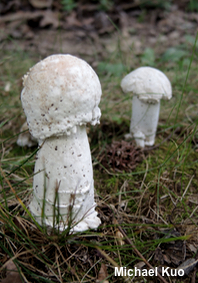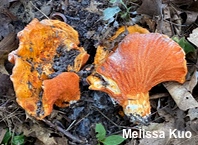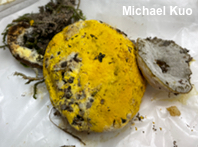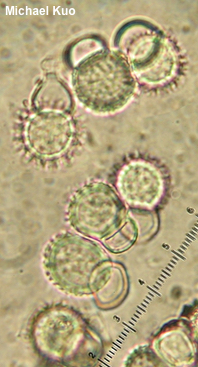| Major Groups > Oddballs & Misfits / Mycotrophs > Hypomyces |

|
[ Ascomycota > Sordariomycetes > Hypocreales > Hypocreaceae . . . ] The Genus Hypomyces by Michael Kuo, 1 October 2023 The species in Hypomyces are fungi that parasitize mushrooms, spreading over their surfaces as powdery tissues and pimply crusts. Often the parasite fungus so transforms its mushroom victim that it becomes hard to tell what the "host" was. (I just have to put "host" in quotation marks, even though that's the term used in mycology; hosting a Hypomyces is like asking the neighbors over for dinner and discovering that you're on the menu instead of those little sweet and sour meatballs you made.) Generally speaking there are two stages—asexual and sexual—in the life of a Hypomyces. At first the fungus is asexual, and reproduces itself by cloning; with maturity the fungus becomes sexual and actual sexual reproduction occurs. These stages are sometimes called "imperfect" and "perfect" states (I bet you can guess which is which), or anamorphic and teleomorphic stages. Many Hypomyces species in the cloning, asexual stage were given scientific names and described in other genera (Cladobotryum, Mycogone, Sepedonium, Verticillium, and others), but current taxonomic rules mandate the use of the genus name representing the sexual stage. Some Hypomyces species (for example the species that attack boletes) are rarely encountered in the sexual stage, while others are rarely found in the asexual stage—and there are plenty of Hypomyces species, in fact, for which the anamorph, or cloning stage, is not known. Thus identification of Hypomyces species does not always rely on consistent features, since cloning-stage fungi and sexual fungi are very different. The key below treats 35 species of Hypomyces that might be expected in North America, and relies on identifying their victims with varying degrees of specificity, along with both macroscopic and microscopic features. For microscopic features I have used three terms that may be unfamiliar to those used to simply looking at "spores": Ascospores are sexual-stage spores that have been produced in asci. This means they will only be found if you are examining a specimen in the sexual stage. Since species of Hypomyces are "pyrenomycetes," this means that tell-tale perithecia will be visible, to the naked eye or at least with the help of a hand lens. Conidia are asexual spores that have been produced on hyphal structures called "conidiophores," most of which (in Hypomyces) look like skinny antlers or candelabras with prongs; the conidia form at the ends of the prongs by dividing themselves off: plop, plop, plop. In Hypomyces the conidia are generally smooth, and ellipsoid to cylindric. Aleuriospores are conidia that have been formed differently; the Dictionary of the Fungi says aleuriospores are "developed from the blown-out end" of a conidiophore, "from which it secedes with difficulty." So, BLAM instead of plop, plop, plop. (Incidentally, the Dictionary also tells us the term "aleuriospore" is "obsol.," but I will continue to use it in this context since Hypomyces literature uses it.) Some of the species in the key are not always as victim-specific as I have portrayed them. Hypomyces aurantius and Hypomyces tremellicola, especially, have been documented on a wide variety of mushrooms (including jelly fungi, chanterelles and trumpets, and others)—and in the case of Hypomyces aurantius, non-mushroom substrates (wood, soil) are sometimes documented. Additionally it should be noted that most of the species concepts in Hypomyces pre-date contemporary, DNA-based research; cryptic phylogenetic species have already been discovered (e.g. Nguyen et al. 2013) and more should be expected . . . possibly making the last month of my life (the time I spent revising my Hypomyces species pages and writing the key below) a waste of everyone's time. It's a good thing I'm retired, lol. |
|
|
Key to 35 Species of Hypomyces in North America
References Das, K. & D. Chakraborty (2013). New record of parasitic macrofungus from India. Indian Journal of Plant Sciences 2: 73–75. Douhan, G. W. & D. M. Rizzo (2003). Host-parasite relationships among bolete infecting Hypomyces species. Mycological Research 107: 1342–1349. Harrison, K. A. & Grund, D. W. (1977). Nova Scotian fleshy fungi: A new albino variant of Hypomyces lactifluorum (Schw. Ex Fr.) Tulasne. Proceedings of the Nova Scotian Institute of Science 28: 87–91. Kim, M., C. Ahn & C. Kim (2017). The fungicolous Ascomycetes genus Hypomyces in Korea. Mycobiology 45: 209–212. Laperriere, G., I. Desgagné-Penix & H. Germain (2018). DNA distribution pattern and metabolite profile of wild edible lobster mushroom (Hypomyces lactifluorum/Russula brevipes). Genome 61: 329–336. Lechat, C., A. Gardiennet & J. Fournier (2017). First report of a lichenicolous species of Hypomyces (Hypocreaceae), H. peltigericola sp. nov. Ascomycete.org 9: 23–26. Parker, A. D. (1990). Noteworthy species of Hypocrea, Hypomyces, and Thuemenella (Ascomycetes, Hypocreales) from Wisconsin. Mycotaxon 38: 77–82. Põldmaa, K. (1996). A new species of Hypomyces and three of Cladobotryum from Estonia. Mycotaxon 59: 389–405. Põldmaa, K., G. J. Samuels & D. J. Lodge (1997). Three new polyporicolous species of Hypomyces and their Cladobotryum anamorphs. Sydowia 49: 80–93. Põldmaa, K. (1999). The genus Hypomyces (Hypocreales, Ascomycota) and allied fungicolous fungi in Estonia. I. Species growing on aphyllophoralean basidiomycetes. Folia Cryptogamica Estonica 34: 15–31. Põldmaa, K., E. Larsson & U. Kõljalg (1999). Phylogenetic relationships in Hypomyces and allied genera, with emphasis on species growing on wood-decaying homobasidiomycetes. Canadian Journal of Botany 77: 1756–1768. Põldmaa, K. & G. J. Samuels (1999). Aphyllophoricolous species of Hypomyces with KOH-negative perithecia. Mycologia 91: 177–199. Põldmaa, K. (2000). Generic delimitation of the fungicolous Hypocreaceae. Studies in Mycology 45: 83–94. Põldmaa, K. (2003). Three species of Hypomyces growing on basidiomata of Stereaceae. Mycologia 95: 921–933. Põldmaa, K. (2011). Tropical species of Cladobotryum and Hypomyces producing red pigments. Studies in Mycology 68: 1–34. Rogerson, C. T. & Simms, H. R. (1971). A new species of Hypomyces on Helvella. Mycologia 63: 416–421. Rogerson, C. T. & G. J. Samuels (1985). Species of Hypomyces and Nectria occurring on Discomycetes. Mycologia 77: 763–783. Rogerson, C. T. & G. J. Samuels (1989). Boleticolous species of Hypomyces. Mycologia 81: 413–432. Rogerson, C. T. & G. J. Samuels (1993). Polyporicolous species of Hypomyces. Mycologia 85: 231–272. Rogerson, C. T. & Samuels, G. J. (1994). Agaricolous species of Hypomyces. Mycologia 86: 839–866. Rossman, A. Y. & 15 coauthors (2013). Genera in Bionectriaceae, Hypocreaceae, and Nectriaceae (Hypocreales) proposed for acceptance or rejection. IMA Fungus 4: 41–51. Valdez, G. U. & G. W. Douhan (2012). Geographic structure of a bolete-infecting cryptic species within the Hypomyces microspermus species complex in California. Mycologia 104: 14–21. This website contains no information about the edibility or toxicity of mushrooms. Cite this page as: Kuo, M. (2023, October). The genus Hypomyces. Retrieved from the MushroomExpert.Com Web site: http://www.mushroomexpert.com/hypomyces.html © MushroomExpert.Com |



